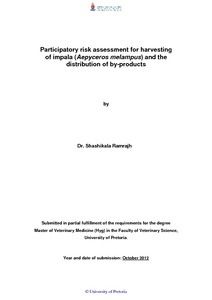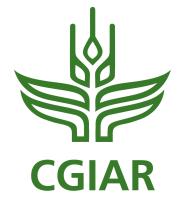Resource information
The demand for the control of safe food, from consumers the world over, has revolutionized the manner in which wild game meat harvesting occurs. In developed countries, food quality, food and human safety with quality controlling systems embracing environmental carbon footprint issues are constantly improving, for international harmonization at each level of production “from stable to table”, “farm to fork”, “field to yield” as well as from “cradle to grave”.
Food industries globally have adopted the in Hazard Analysis Critical control Point (HACCP) system. This is a risk assessment process using Hygiene Assessment Systems (HAS) as a mitigating strategy for risk communication through training. It is also a holistic system that is compatible with international trends designed not only for food safety and quality, but it also embraces other aspects of farming such as animal welfare, environmental management and Occupational Safety and Health.
Global marketing for international trade demands quality assurance from trading partners thereby promoting economic growth for developing countries. The watch dog bodies such as the World Trade Organisation (WTO) prohibit trading for non-compliance, therefore trade barriers are in place for uncertified food of animal origin, EU regulations are stringent requirements that need compliance and so too the OIE regulations for disease control, while the Codex Alimentarius Commission maintains trade harmonization.
In South Africa Hygiene Assessment Systems (HAS) is a National Hygiene management strategy implemented at abattoirs, that promotes and facilitates quality and hygiene and is reflective of South African quality abroad. It is prescribed under the section, “Essential National Standards” in the Meat Safety Act, 2000, (Act 40 of 2000). This Act covers red meat and includes both domestic animals and game. The Veterinary Procedural Notices (VPN’s) are used for export of game and give far more detailed guidelines than the legislation for game meat sold and consumed locally in South Africa.
The objective of the Hygiene Assessment System (HAS) is to create a national awareness of quality to better improve the quality of life of all South Africans, whilst at the same time it is used as an auditing tool for Veterinary Public Health to effectively compare essential standards within the nine provinces. Currently this programme is referred to as the National Abattoir Rating Scheme (NARS), which is only applicable to the high and low throughput Red Meat and Poultry abattoirs in South Africa and not to the Game or Rural abattoirs, thereby further compounding the duality of food standards with food safety being compromised.
This study has been undertaken because there are inadequate risk control measures such as introduction of Hazard Analysis Critical Control Point (HACCP) guidelines on primary and secondary meat inspection, specifically on game for local consumption, not only within South Africa, but in the international arena as well. A revision of the HAS document and audit will also be needed to meet with the local (not just export) criteria for wild game harvesting, to enable food safety, thus enabling food security in the remote non - agricultural areas in KwaZulu -Natal.
Venison is the meat of today because of health priorities that have arisen over the last ten years. It is low in trans - fatty acids and is regarded internationally as a healthy product produced organically in a free range situation. South Africa has a large potential export market for venison to the European Union because the demand, for venison, exceeds supply in Europe. However, the European Union’s “safe food regulation” that was introduced between 2005 and 2007 with an implementation date of 2008 (Regulation1021/2008) has made it imperative that the HACCP principle is applied to any food or food product of animal origin imported into the European Union or its member states. Also, HACCP specifies that a multidisciplinary team of experts is selected. This then lends itself to a participatory approach to risk assessment as wide consultation is required. This participatory approach was used, including expert opinion surveys and focus group discussions with stakeholders and role-players in the game industry such as commercial hunters, state veterinary services and game ranch owners. Such participants may have better insight into existing conditions than external experts with recognised educational qualifications, usually used in the HACCP team. From this and the relevant Veterinary Procedural Notices for game harvesting, a HACCP process flow and critical control points were derived for the primary phase of meat inspection, including slaughter, primary meat inspection and loading for transport to the abattoir. This was modified during a phase or trial harvesting and then implemented during the harvest of 1758 impala carcasses which were subsequently exported. In addition, environmental risks were considered and a risk mitigation strategy designed, to reduce any possible environmental impacts.
In northern Kwazulu Natal, game ranches and conservation areas are in close proximity to the rural poor where food is scarce and comes at a premium price.
These game farms harvest seasonally for either the local or export market, hence there is abundance of game offal and by-products available, yet it is at present left in the field or taken to the vulture restaurants (in line with the VPN). Participatory risk analysis was thus also used to investigate the feasibility of using edible offal from impala (Aepyceros melampus) as a source of renewable protein, to address food security issues in impoverished communities in the study area, the districts of uPongola and Jozini, in northern KwaZulu Natal. Structured interviews on the cultural acceptability of impala offal were held with 162 randomly sampled adult respondents in veterinary districts associated with dip tanks. A two stage cluster design was used where the state veterinary areas were stage one and the dip tanks (with proportional random sampling of community members) were the second stage. Offal is a popular food in South Africa in different cultures, called “ithumbu” in IsiZulu, “ boti” by the Indian group, “afval” in Afrikaans and “tripe” in English. Generally demand outstrips supply of offal at red meat abattoirs in South Africa. It was found that there was no significant difference between those who would eat impala offal and those who would eat the offal of sheep.
It was concluded that it is feasible to use inspected game offal from impala as a protein source in much the same way as red meat offal is used and that the current practice of leaving the offal for predators was likely, if it continues, to cause imbalances in the predator/ prey ratio on game farms.
It is recommended that the VPN for game be amended to encompass inspected offal being allowed into the formal food chain, in line with the standard operating procedure developed during this study. Also that current fragmentation of legislation and the implementation thereof is revisited for effective control for harmonisation of food safety standards for game meat within South Africa.



